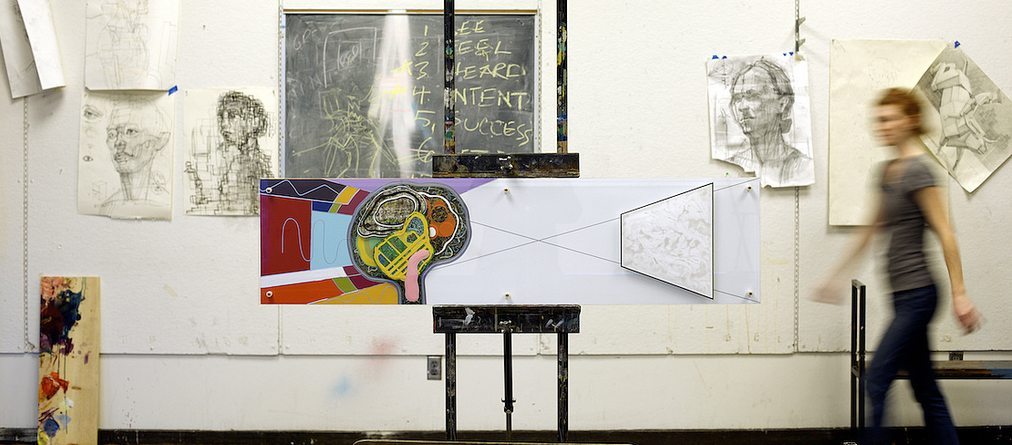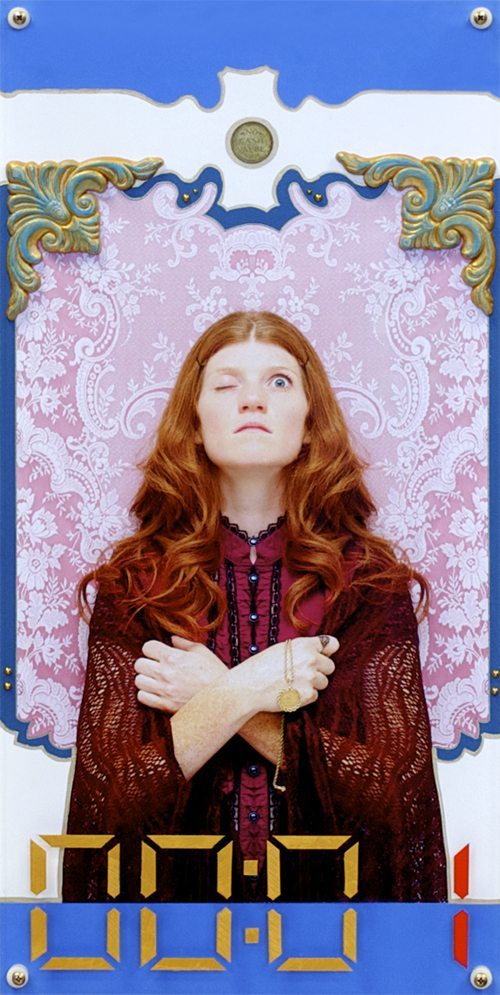Our next Artist Spotlight features Meggie Troili. Her work deals with grave issues—biology, technology, death, or aging. But her style, which she calls crystalline pop (featuring a combination of photography and photo-based collage), injects the bright sweetness of everything bubblegum into these heavy subjects, without sacrificing the sublime or transformative spiritual aspects of her work.
Transformative is a key word in Troili’s personal journey to artist-hood as well. As a child, collage was Troili’s expressive escape, but it wasn’t something that was considered serious or important—a societal misperception often applied to the arts, but doubly so when the art form is embraced by youngsters and triply so when “embraced by youngsters” becomes “embraced by young women.” It wasn’t until Troili became an art educator and art advocate helping others embrace their artistic sides that she came to embrace her own creative vision. If you are struggling to accept your own vision, or are interested in learning from Troili how to take charge of your artistic destiny, read on:

How long have you been making/creating?
Growing up, one of my favorite things to do was to read interior design and landscape magazines and cut images out. I’d rearranged and redecorate my room every three months, and I would also design and decorate the yard. I loved the design aspect of all that—creating comfortable spaces inside and outside. My favorite classes were always art classes, and I doodled on everything, even my walls and door in my bedroom. But I never thought it was possible for me to be an artist—I never had the belief that I could be anything that I wanted.
 How did you get started?
How did you get started?
It was always a dream of mine to be an artist or work in the creative fields, but I didn’t know how to do it, or how to even pursue it, so I went into the medical field. I worked as a dialysis technician for six and half years, and I was planning on becoming a nurse. When I was studying to be an RN, I just woke up one day and realized that it wasn’t making me happy, and I decided to check out the art department. At the end of the meeting with the guidance counselor, she suddenly said, “so, do you want me to change your major?” I was surprised, and blurted out, “Sure!“ I was 29 years old—and I didn’t create my first real piece until I was in art school.
Even in art school, I was too scared to just be an artist, so I decided to get an art education degree. That was when it really clicked for me: I was learning how to teach other people to follow their creative dreams and their passions, and I was learning to be the support that creative don’t usually get anywhere else in their lives. I taught private art classes, worked for a few organizations that worked with troubled teens, kids with learning disabilities, or autism—it was amazing for me to see the power that art gave them, and it was a great to help these youth that really don’t have that sense of power and expression discover that.
I still consider myself an art educator, and that has helped me feel comfortable as an artist.
Tell us about your work.
I create questions or themes in my life. Right now I’m focused on “skin.” I’ve noticed mine changing, and I’ve started to observe my mother’s and my grandmother’s skin—it’s becomes a living timeline of where I’m headed, physically. I’ve been taking photos of my skin, and of my mother’s and my grandmother’s, and printing them on photo paper—I’m analyzing them, and trying to come to terms with the process of aging physically as I collage them.
I want to take these awkward topics—death and aging skin—and confront them. I want to make them okay, beautiful, accessible. I’m creating these memento mori pieces—l but I want to take this old, creepy symbology like the candle and the skull,and bring it up to date and make the symbols modern and relevant.
As a collage artist, I actually spend most of my time searching for my medium: I go to fabric stores, hardwood stores, automotive stores, come up with whole composition in my head while looking for materials, and then I throw my projects together, and then I just do it. The hunt for materials is almost like transcendental meditation—I’m walking around meditating on these subjects as I’m searching for these mediums.
I’ve always worked in collage—but it seemed very “Home Ec”, and before I really learned the history of it, when I first started art school, I didn’t want to be a collagist—I didn’t think it was important enough… collage didn’t seem as being a “Great Painter”! So I held back from being a collagist for a few years—actually, I really fought against it, before surrendering to it. That is why I am so passionate about art education, because I want the people I work with to believe that whatever art form they are passionate about is not only okay but important.
Tell us about another local/other locals whose work inspires you. (This can be local musicians, artists, writers, etc.)
All of my professors at the University of Utah were my biggest supporters, they supported me more than anyone ever has as an artist. I was also part of the Ernesto Pujol performances piece Awaiting in 2010—a 14 hour walk in silence that was open to anyone who wanted to participate. At the Leonardo, working with Jann Haworth—she has been so supportive and a great mentor, I couldn’t ask for a better artist to work with, and I mean literally work with as a coworker and as a friend. And the same for everyone at the Leonardo, we get to constantly collaborate and create here at the museum and we get to inspire the community to do the same thing.
Where might people see your work, or have seen your work, locally?
Well, I’m at the Lab@Leo this weekend, and you can find my work at my Flickr page, Crystalline Pop.
How do you feel about the local art scene, or about Utah as location to live the creative life?
What helped me the most as an artist was connecting with the community here—you really have to put yourself out there. There is a strong art community in Salt Lake, but you do have to go find it: you have to go out to galleries, network, and just attend as much as you can. There are a lot of community generated projects, like the 337 Project for instance, that post call-outs that are open to anyone in the community. I also find that Facebook is a great way to stay connected and find artistic friends on the internet has been huge, and I’ll friend artist before I know them in person—you have to put yourself out there and make connections.
What do you do to keep your creative juices flowing?
To make art, I stay curious about the world around me, and I stay curious about myself as a human being. The most important thing that I do as an artist is make the first move—I can sit and think about my work or think about what I want to do for 24 hours a day—but a single brushstroke, starting a Photoshop file titled “new work”, getting my camera out of the bag… Until I do that, nothing is going to happen. Somehow, that first move starts the domino effect, the next thing I know, I have a new piece of work.
Meggie Troili will be at the Leonardo’s Lab@Leo as a resident artist today and tomorrow, Sunday April 8th. The Leonardo, 209 East 500 South.
